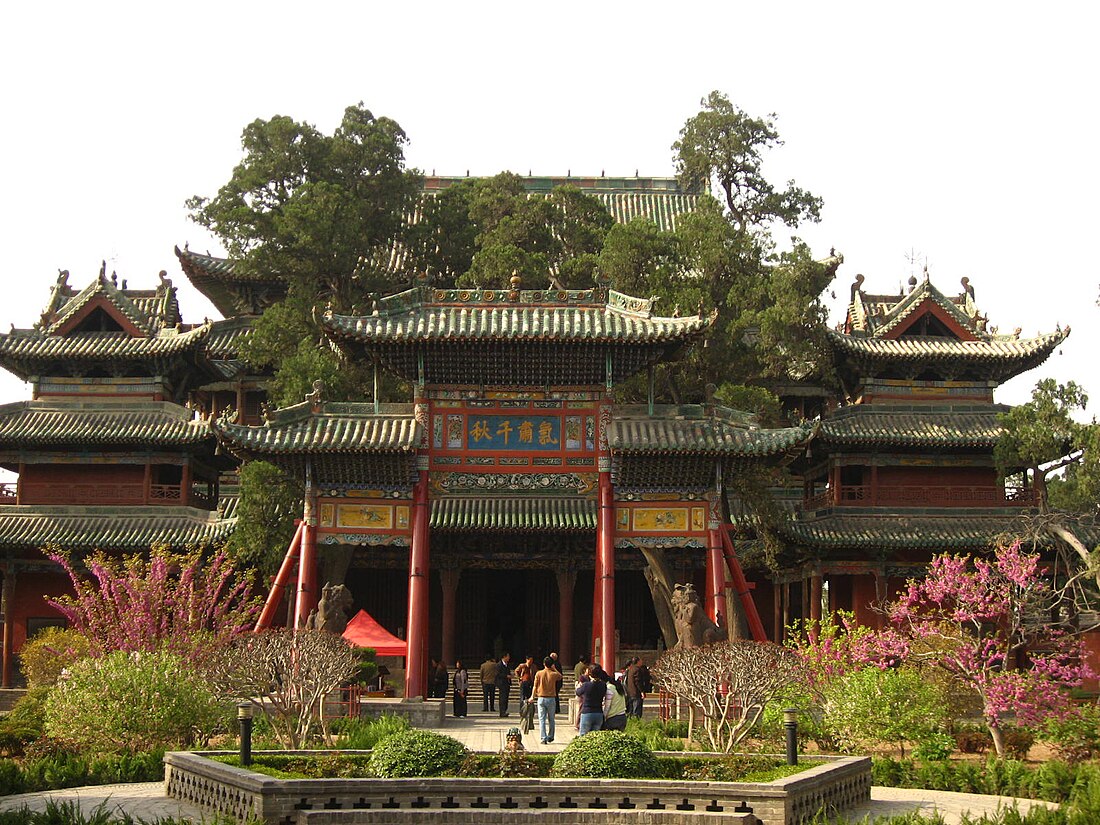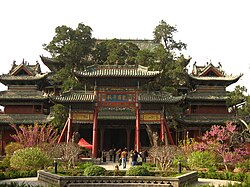Top Qs
Timeline
Chat
Perspective
Yuncheng
Prefecture-level city in Shanxi, People's Republic of China From Wikipedia, the free encyclopedia
Remove ads
Yuncheng (simplified Chinese: 运城; traditional Chinese: 運城市) is the southernmost prefecture-level city in Shanxi province, People's Republic of China. It borders Linfen and Jincheng municipalities to the north and east, and Henan (Luoyang and Jiyuan to the east, Sanmenxia to the south) and Shaanxi (Weinan) provinces to the east, south and west, respectively. As of the 2020 census, its population was 4,774,508 inhabitants (5,134,779 in 2010), of whom 928,334 (680,036 in 2010) lived in the built-up (or metro) area made of Yanhu District. One can note than Pinglu County, 205,080 inhabitants in the south, is now part of Sanmenxia built-up (or metro) area.
This article needs additional citations for verification. (August 2012) |
You can help expand this article with text translated from the corresponding article in Chinese. Click [show] for important translation instructions.
|
Yuncheng is a city that was born and prospered from salt. It is named after the "City of Salt Luck".[3]
Remove ads
Name
Yuncheng was called the "Salt Family" in the Spring and Autumn Period. In the Han Dynasty, the salt city was named "Siyan City". Emperor Taizong of the Yuan Dynasty named Yuncheng Salt Lake "Shenghui Town" because it benefited the world. The city was built at the end of the Yuan Dynasty and was named "Phoenix City" was later renamed "Yuncheng" because of the "City of Salt Luck".[4]
History
Summarize
Perspective
This section needs expansion. You can help by adding to it. (August 2012) |
Yuncheng is one of the important birthplaces of Chinese civilization. The legendary Chinese ancestors such as Nuwa, Lei Zu, Chi You, Shun, and Yu all lived here. Yu established the Xia Dynasty here. During the Warring States Period, the Wei State established its capital here. Anyi, the capital of Wei, was located in Xia County, Yuncheng today.[5]
Hedong Salt Pond is the earliest salt pond developed and utilized in the world, with a mining history of more than 4,600 years. As an important strategic resource, salt ponds were the common goal of various tribes in the Central Plains of China in ancient China. From the ancient legend of the Yellow Emperor's battle with Chiyou, to the historical records of King Mu of Zhou, Emperor Cheng of Han, Emperor Zhang of Han, Emperor Taizong of Tang, Kangxi and other emperors visiting successively, the Hedong Salt Pond has been regarded as a "national treasure" by successive dynasties.[6]
In early China,[when?] it was the location of the state of Kunwu (昆吾). Yuncheng was the site of the Yuncheng Campaign (三打运城), battle between the Kuomintang army and the People's Liberation Army during Chinese civil war.
The famous general Guan Yu from the late Han dynasty was also born in this region.
Yuncheng currently has 6,205 immovable cultural relics, 102 national key cultural relics protection units, and 55 wooden buildings before the Yuan Dynasty.[7]
Remove ads
Archaeology
In July 2022, archaeologists announced a discovery of a 2.8 cm long 5,200 years old stone carving chrysalis in a semi-crypt house at the Shangguo Site in Wenxi County. Archaeologists made suppositions that this house may have belonged to the Yangshao Culture period, based on the unearthed pottery pieces. According to archaeologist Tian Jianwen, the discovery of stone carving chrysalises provided significant information for the study of the silkworm culture in China.[8][9]
Administration
Summarize
Perspective
Yuncheng is located between 34°35′-35°49′ north latitude.[10] There are 13 county-level administrative divisions under Yuncheng's jurisdiction, including 1 district, 10 counties and 2 county-level cities. The Municipal executive, legislature and judiciary are in Yanhu District (盐湖区), together with the CPC and Public Security Bureau.
Remove ads
Climate
Summarize
Perspective
Yuncheng has a continental, monsoon-influenced semi-arid climate (Köppen BSk), with four distinct seasons.[11] Due to its southerly location and position to the north of the Zhongtiao Mountains, allowing for downsloping when winds are from the south, it is among the warmest locales in the province. Winters are cold and very dry, while summers are hot and humid. Monthly mean temperatures range from −0.6 °C (30.9 °F) in January to 27.5 °C (81.5 °F) in July, and the annual mean is 14.23 °C (57.6 °F). Over 60% of the annual rainfall occurs from June to September.The average frost-free period across the city is between 188 and 238 days.[12] With monthly percent possible sunshine ranging from 45% in March to 54% in May and July, the city receives 2,219 hours of bright sunshine annually, low by Shanxi standards and North China.
Remove ads
Notable people
- Guan Yu, general and deified historical figure
- Guan Hanqing, Dramatist
- Jing Haipeng, PLAAC astronaut
- Zhang Ziyi, Chinese zootechnician
- Gladys Aylward, British missionary who works in the city in the 1930s

Transportation
- Yuncheng Station Has a maximum daily passenger volume of 14,000[16]
- China National Highway 209
- G59 Hohhot–Beihai Expressway
- Datong–Xi'an Passenger Railway, with frequent service to Beijing, Taiyuan, and Xi'an.[17] Besides the Yuncheng North Railway Station (near Yuncheng's central city), the railway also has stations at Yongji and Wenxi.
- Yuncheng Zhangxiao Airport It has opened 22 domestic routes including Beijing, Shanghai, Tianjin, Guangzhou, Shenzhen, Chengdu, Chongqing, Shenyang and Urumqi, transporting more than 1 million passengers annually.[18]
Remove ads
See also
Notes and references
Wikiwand - on
Seamless Wikipedia browsing. On steroids.
Remove ads









